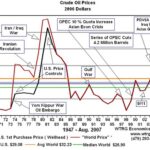Nvidia Corp. (NASDAQ: NVDA), continues to struggle in gaining upward momentum, after President Trump announced on April 2 nd new reciprocal tariffs against dozens of countries including China.
China has already indicated plans to impose retaliatory duties on American goods as a response to Trump’s new policy, which could trigger a trade conflict between the two largest economies.
A similar backdrop could hurt US companies with significant revenue exposure in China. Goldman Sachs has identified Nvidia Corp as one of these names.
China’s contribution to Nvidia revenue
Goldman Sachs believes that Sino-US trade tensions will be a significant headwind for NVDA, as the Greater China region is currently responsible for 39% of NVDA’s annual revenue.
Nvidia’s export-oriented H20 chips have been in high demand, particularly from major Chinese tech companies such as ByteDance Tencent and Alibaba.
The Trump administration has continued to tighten the restrictions on chip exports that are bound to hurt the titan’s business in the future.
China has also started to advise its companies not to use Nvidia chips, as they reportedly do not comply with the latest energy efficiency standards in the country.
Goldman Sachs strategists added that these factors could have a material impact on NVDA’s future revenues.
NVDA is a Wall Street favorite
Wall Street is still bullish on Nvidia despite the new tariffs on China, and the possibility that President Xi will announce retaliatory duties on American goods.
The consensus rating for NVDA shares is currently “buy”, with a mean target price of $176. This indicates a potential 70% increase from current levels.
Statista predicts that the AI market will grow at an annual compound rate of over 26% by the end of the decade.
Nvidia also pays a 0.036% dividend yield, making it attractive to income investors.
LVS has a major revenue exposure in China
Goldman Sachs believes that casino stocks, namely Las Vegas Sands Corp. (NYSE: LVS), are the most vulnerable to Sino-US trade tensions by 2025.
LVS has a significant presence in Macao. It is also known as “Las Vegas of Asia” due to its popularity. Macao is the source of more than 60% revenue for the US casino and resorts company.
Analysts are also bullish about Las Vegas Sands, but not as much as Nvidia.
At the time of writing, LVS’s consensus “buy” rating was accompanied by a median target of approximately $59
This translates into a potential gain of nearly 50% in the dividend stock, which currently yields 2.56 %.
This post is about how dependent Nvidia is on China to generate revenue. This post may be updated as new information becomes available
This site is for entertainment only. Click here to read more






